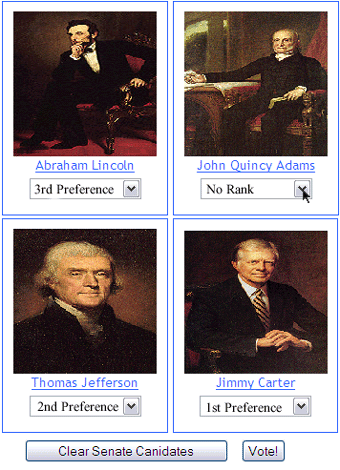With 135 candidates to choose from, we thought
we had a lot of voting options in our recent Governor Recall
election. But one month later, on

No, Jimmy Carter didn't run for
ASUCD senate; he simply appeared on the ASUCD's sample
balot so that students could take a crack at choice
voting before the big election day. To get a look at
the recent ASUCD election process, visit their site
at http://elections.ucdavis.edu.
|
November 12 to 14, UC Davis students found their voting options
even more diverse. For the first time on campus, students used
the new Choice Voting system in which voters don’t just
choose their favorite candidate, they can also rank as many
other candidates as they choose in their order of preference.
With 16 candidates on the ballot (to fill six ASUCD senators
seats), this sort of system requires sophisticated software
to tally the voting and a smooth integration of that software
onto the election Web site, where students cast their votes
electronically.
In traditional voting systems, the candidate with the most
votes wins, regardless of whether he or she has a majority
of the vote. For instance, the well-known winner of the recent
California Recall election actually
garnered less than a statistical majority, bringing in only
49% of the vote. Last winter, however, UC Davis undergraduates
voted to pass an amendment to the ASUCD constitution, making
choice voting the official voting system for ASUCD elections.
Choice voting
stipulates a candidate must receive a majority of the vote (or
a threshold of the votes in multi-winner elections) in order
to take office, and it ensures majority support by taking into
account voters’ second, third, and fourth choices.
Choice Voting Demystified
Called ‘Instant Run-Off Voting’ when one winner is being
elected and ‘Single-Transferable Voting’ when multiple
winners are elected, choice voting seems like a mathematical puzzle
at first.
UC Davis voters log on to the secure elections Web site where
they can view candidate’s pictures, read candidate bios and
cast their vote (ASUCD elections have been entirely online for several
years). Voters click on candidate pictures to rank them in order
of first choice, second choice, third choice and so on. It should
be noted, however, that voters are not required to rank all the
candidates; they can rank as many or as few as they wish.
In single-winner elections, if no single candidate receives a majority
of the vote, the candidate with the fewest votes is eliminated from
the race. The losing candidate’s votes are then re-distributed
among the remaining candidates based on voters’ next available
choice indications. The tallying continues through rounds of elimination
and re-tallying until one candidate receives a majority of the votes.
When electing more than one person, as in the case of the recent
ASUCD election, winning candidates must achieve a threshold of the
vote, in this case roughly 14% or 350 votes. If none of the candidates
receive the threshold, elimination rounds begin. On the other hand,
if a candidate exceeds the voting threshold, a portion of his or
her excess votes over the threshold are divided among the voters’
next choices. Sound confusing?
Check out the ASUCD election results page at http://asucd.ucdavis.edu/elections/
to get an idea of how the votes and fractions-of-votes transfer
from candidate to candidate through the tallying rounds.
With all this cascading of votes through multiple rounds, the
tallying process can seem a bit dizzying. According to mathematics
graduate student Chris Jerdonek, one of the students who helped
raise campus interest in choice voting, Cambridge, Massachusettes
and UC Berkeley began tallying their choice voting elections by
hand, using nothing more than a pen, paper and good old-fashioned
mathematics. When UC Davis adopted choice voting, the decision to
use a computer for vote-tallying was a no-brainer. The only question
was what software to use.
Preparing the Technology for Election Day
ASUCD called upon its media and technology staff early in the summer
to begin designing vote-tallying software and a user-friendly voting
Web site for the upcoming fall election. The elections Web site
and vote-tallying software were developed by ASUCD Creative Media
student employees Tom Burnett and DJ Davis and staff programmer
Alex Park. The ASUCD-created system is double-checked by professional
choice voting software, ChoicePlus, which is used at a handful of
other universities around the country.
Burnett, who did most of the programming to create the vote-tallying
software, said that it took three revisions to get every aspect
of the Cold Fusion and Oracle-backed program correct. There were
many challenges that came along with the project, including making
the Web site compatible with all the different Web browsers in use
by student voters, and ensuring that the program’s voting
sessions wouldn’t time-out on voters before they had a chance
to select all their preferences.
“We had a mock election with a few hundred people in order
to give our software a trial run,” says Park. The programmers
also posted a sample ballot –featuring past American presidents
posing as candidates– on the site in the weeks prior to the
election so that students could get a feel for the new voting process
ahead of time.
Student Voters Adjust to New System
Using the choice voting system for the first time, most voters failed
to take advantage of the chance to rank all 16 candidates, generally
logging on, voting for their six slate candidates, and logging off.
Election Committee Chair Mary Ball feels it will “take a while”
for people to get used to the system. Some students, such as geology
undergraduate Dierdre Williams found the process of marking multiple
preferences a bit “tedious.” However, Dan Reilly, an
undergraduate studying classics felt the extra pointing-and-clicking
was worth it since “choice voting allows the voter to split
votes into a more realistic and accomodating ranking system instead
of the black/white voting of previous years.” |